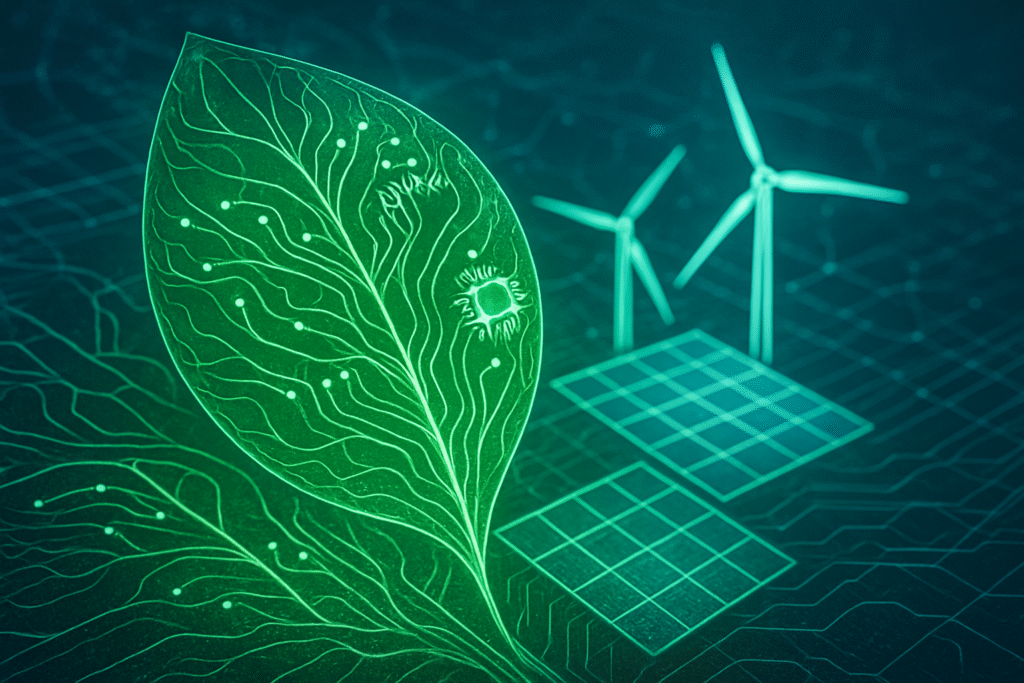
The global push towards a sustainable future is accelerating, and at its core lies an often-unsung hero: the semiconductor industry. Far from being merely the engine of our digital lives, advancements in chip technology are now proving indispensable in the renewable energy transition, driving unprecedented progress in how we generate, store, and manage sustainable power. This silent revolution, particularly propelled by emerging materials like organic semiconductors, is fundamentally reshaping the landscape of green energy solutions, promising a future where clean power is not only efficient but also ubiquitous and affordable.
This pivotal role of semiconductors extends across the entire renewable energy ecosystem, from maximizing the efficiency of solar panels and wind turbines to enabling sophisticated battery management systems and intelligent smart grids. The immediate significance of these developments cannot be overstated; they are directly accelerating the adoption of renewable energy, enhancing grid resilience, and dramatically reducing the cost and accessibility barriers that have historically hindered widespread green energy deployment. As the world grapples with climate change and escalating energy demands, the continuous innovation within chip technology stands as a critical enabler for a truly sustainable future.
Organic Semiconductors: A Technical Leap Towards Ubiquitous Green Energy
The technical landscape of renewable energy is being profoundly reshaped by advancements in semiconductor technology, with organic semiconductors emerging as a particularly exciting frontier. Unlike traditional silicon-based chips, organic semiconductors are carbon-based molecules or polymers that offer a unique blend of properties, setting them apart as a game-changer for sustainable solutions.
A significant breakthrough in organic solar cells (OSCs) has been the development of Non-Fullerene Acceptors (NFAs). These novel materials have dramatically boosted power conversion efficiencies, with laboratory results now approaching and even exceeding 19% in some instances. This is a crucial leap, as earlier organic solar cells often struggled with lower efficiencies, typically around 11%. NFAs address the challenge of exciton binding – where electron-hole pairs formed after light absorption are tightly bound – by facilitating more efficient charge separation. Furthermore, extensive molecular engineering allows researchers to precisely tune the band gap and other electronic properties of these materials, optimizing light absorption and charge transport. This design flexibility extends to creating new organic molecules, such as P3TTM, that exhibit quantum mechanical behaviors previously seen only in inorganic materials, potentially simplifying solar panel construction. Advanced device architectures, including bulk heterojunctions (BHJs) and multi-junction cells, are also being employed to maximize light capture across the solar spectrum and overcome the inherent short exciton diffusion lengths in organic materials.
These technical specifications highlight the distinct advantages of organic semiconductors. Their inherent flexibility and lightweight nature mean they can be deposited onto flexible substrates using low-cost, low-temperature, solution-based processing methods like roll-to-roll printing. This contrasts sharply with the energy-intensive, high-temperature processes required for crystalline silicon. While commercial crystalline silicon cells typically boast efficiencies between 20% and 25%, the rapid improvement in organic solar cells, coupled with their semi-transparency and tunable properties, opens doors for novel applications like solar windows and integration into curved surfaces, which are impossible with rigid silicon. However, challenges remain, particularly regarding their shorter lifespan and lower charge carrier mobility compared to silicon, areas where active research is focused on improving stability under real-world conditions.
The initial reactions from the AI research community and industry experts are a mix of optimism and pragmatism. There's widespread recognition of organic semiconductors as a "next-generation technology for a greener future" due to their sustainability, low fabrication cost, and diverse performance capabilities. Crucially, the AI community is actively contributing to this field, leveraging machine learning to accelerate the discovery of new materials, significantly reducing the experimental cycles needed for breakthroughs. Experts emphasize that while efficiency is important, the primary focus is now shifting towards enhancing long-term stability, scalability, and practical integration. The potential for low-cost, mass-produced plastic solar cells with a low embedded energy footprint is seen as a major market disruptor, although widespread commercial use in large-scale solar panels is still in its developmental stages, with existing applications primarily in consumer electronics displays.
Corporate Fortunes and Competitive Shifts in the Green Chip Era
The advent of advanced semiconductor technologies, particularly organic semiconductors, is poised to trigger significant shifts in corporate fortunes and reshape competitive landscapes across the tech and energy sectors. This revolution presents immense opportunities for agile innovators while demanding strategic recalibration from established giants.
Companies specializing in Organic Photovoltaics (OPVs) and their material components are at the forefront of this benefit. Innovators like Heliatek GmbH, a pioneer in flexible organic solar films, are carving out niches in building-integrated photovoltaics (BIPV), automotive applications, and consumer electronics. Similarly, BELECTRIC OPV GmbH and ASCA are leveraging printed photovoltaic technology for customizable modules in smart textiles and architectural designs. Material specialists such as Novaled and Epishine are crucial, providing the high-performance organic materials and focusing on scalability for various appliances. Even traditional solar panel manufacturers like JinkoSolar (NYSE: JKS) and Vikram Solar could strategically integrate these technologies to diversify their offerings and tap into new markets. Beyond solar, the enhanced power management capabilities enabled by efficient organic semiconductors could indirectly benefit wind power giants like Vestas (CPH: VWS) and major Electric Vehicle (EV) manufacturers by optimizing energy flow and battery life.
The competitive implications for major chip manufacturers and tech giants are profound. While organic semiconductors challenge the long-standing dominance of silicon due to their flexibility, lightweight nature, and lower production costs, they also present immense opportunities for tech titans. Companies like Apple (NASDAQ: AAPL), Google (NASDAQ: GOOGL), Samsung (KRX: 005930), and Amazon (NASDAQ: AMZN) stand to benefit significantly from integrating thin, flexible, and even transparent organic solar cells into consumer electronics, enabling self-charging capabilities and extended battery life for devices ranging from smartphones to VR headsets. This could lead to sleeker designs, enhanced product differentiation, and potentially transparent solar-harvesting displays. However, traditional semiconductor manufacturers must adapt. The shift towards more environmentally friendly, solution-based manufacturing processes for organic semiconductors could reduce reliance on the complex and often vulnerable global silicon supply chain. Major players may need to invest heavily in R&D, forge strategic partnerships, or acquire startups specializing in organic materials to secure intellectual property and manufacturing capabilities in this evolving domain. Material science giants like Merck KGaA (ETR: MRK), BASF SE (ETR: BAS), and Sumitomo Chemical (TYO: 4005) are already focusing on material diversification to capitalize on this trend.
The disruptive potential of organic semiconductors is already evident in display technology, where Organic Light-Emitting Diodes (OLEDs) have largely supplanted Liquid Crystal Displays (LCDs) in small to medium-sized applications and dominate the premium television market. Companies like Samsung Display Co., Ltd. and LG Display Co., Ltd. (KRX: 034220) have been key disruptors here. Looking ahead, flexible, transparent, and ultra-light OPV films could disrupt traditional rooftop solar installations by enabling energy harvesting from unconventional surfaces like windows or curtains, creating entirely new markets. For low-power Internet of Things (IoT) devices, integrated organic solar cells could eliminate the need for conventional batteries, simplifying deployment and maintenance. Furthermore, Organic Thin-Film Transistors (OTFTs) are paving the way for mechanically flexible and foldable electronic products, leading to innovations like electronic paper and "smart" clothing. Companies that strategically invest in these areas will gain significant advantages in product differentiation, sustainability branding, and cost-effectiveness, potentially creating new market segments and securing robust intellectual property.
A Broader Horizon: Integrating AI and Sustainability with Organic Chips
The rise of organic semiconductors extends far beyond incremental improvements in renewable energy; it signifies a profound shift in the broader AI landscape and global sustainability efforts. This technology is not merely an alternative but a crucial enabler for a future where AI is more pervasive, efficient, and environmentally responsible.
In the AI landscape, organic semiconductors are poised to facilitate a new generation of hardware. Their inherent flexibility and low-power characteristics make them ideal for the burgeoning fields of wearable AI, smart textiles, and implantable medical devices. Imagine biosensors seamlessly integrated into clothing for continuous health monitoring or flexible displays that adapt to any surface. Crucially, organic semiconductors are vital for low-power and edge AI applications, where processing occurs closer to the data source rather than in distant data centers. This reduces latency and energy consumption, critical for the proliferation of IoT devices. Furthermore, organic electronics hold immense potential for neuromorphic computing, which aims to mimic the human brain's structure and function. By enabling components that integrate sensing, memory, and processing—often separate in traditional systems—organic semiconductors can lead to significantly more energy-efficient and high-performing AI hardware. Paradoxically, AI itself is playing a pivotal role in accelerating this development, with machine learning algorithms rapidly discovering and optimizing new organic materials, significantly shortening the traditional trial-and-error approach in materials science.
The societal and environmental impacts are equally transformative. Socially, biocompatible and flexible organic semiconductors promise to revolutionize healthcare with advanced monitoring and diagnostics, including innovative treatments like photovoltaic retinal prostheses. Their printability and lower production costs could also lead to more affordable and accessible electronics, helping to bridge technological divides globally. Environmentally, organic semiconductors offer a significant reduction in carbon footprint. Unlike conventional silicon, which demands energy-intensive, high-temperature manufacturing and often involves toxic metals, organic materials can be produced using low-temperature, less energy-intensive processes. Many are also biocompatible and biodegradable, offering a potential solution to the escalating problem of electronic waste (e-waste) by being recyclable like plastics. Organic photovoltaics (OPVs) provide a greener alternative to traditional silicon solar cells, utilizing earth-abundant materials and enabling seamless integration into buildings and vehicles through their transparent and flexible properties, expanding solar energy harvesting possibilities.
However, potential concerns remain. While efficiency has improved dramatically, organic solar cells still generally have shorter lifespans and lower power conversion efficiencies compared to crystalline silicon, with degradation due to environmental factors being a persistent challenge. Scalability of manufacturing for high-performance organic devices also needs further optimization. Moreover, the energy consumption of the AI tools used to discover these materials presents an interesting paradox, underscoring the need for energy-efficient AI practices. Geopolitical factors, resource constraints, and trade restrictions impacting the broader semiconductor industry could also affect the supply chain and adoption of organic semiconductors. When compared to previous AI and energy milestones, organic semiconductors represent a fundamental paradigm shift. In AI, they move beyond the limitations of rigid, energy-intensive silicon, enabling a future of pervasive, low-power, and flexible intelligence. In energy, they herald a "greener" third wave of solar technology, moving beyond the rigidity and e-waste concerns of traditional silicon panels towards a future where energy harvesting is seamlessly integrated into our built environment, akin to how the invention of the electric generator revolutionized energy distribution. This evolution signifies a concerted move towards sustainable technological progress.
The Road Ahead: Unlocking the Full Potential of Organic Chips for Green Energy
The trajectory of organic semiconductors in renewable energy is one of continuous innovation and expanding horizons. Both near-term and long-term developments promise to solidify their role as a cornerstone of sustainable power, although significant challenges must still be navigated for widespread commercial viability.
In the near term (the next 1-5 years), we can expect to see organic photovoltaic (OPV) cells push laboratory power conversion efficiencies (PCEs) beyond the 20% mark for single-junction cells, building on the success of non-fullerene acceptors (NFAs). This will bring them increasingly closer to the performance of traditional silicon. A critical focus will also be on significantly improving long-term operational stability and durability under diverse environmental conditions, with ongoing research in phase stabilization and compositional engineering. Furthermore, the industry will concentrate on scaling up manufacturing processes from laboratory to commercial-scale production, leveraging solution-based methods like roll-to-roll printing to reduce costs and complexity. A deeper understanding of fundamental electronic processes, such as "entropy-driven charge separation" in NFAs, will continue to drive these improvements.
Looking further ahead, the long-term vision includes the development of highly efficient hybrid organic-perovskite tandem cells, designed to capture an even broader spectrum of light. Advanced material design, process refinement, and interface engineering will further augment the efficiency and durability of OPVs. Crucially, Artificial Intelligence (AI), particularly machine learning, is predicted to play a paramount role in accelerating the discovery and optimization of new organic solar materials and device designs, analyzing vast datasets to predict PCE and stability with unprecedented speed. This synergistic relationship between AI and material science will be key to unlocking the full potential of organic semiconductors. The widespread adoption of transparent and flexible organic solar cells for building-integrated photovoltaics (BIPV), smart windows, and self-powered smart textiles is also on the horizon, enabling a truly distributed energy generation model. Beyond solar, organic thermoelectrics (OTEs) are being developed to convert waste heat into electricity, offering flexible and environmentally friendly solutions for waste heat recovery in various applications.
These unique properties—flexibility, lightweight nature, transparency, and low-cost manufacturing—open up a vast array of potential applications. Transparent organic solar cells can be seamlessly integrated into windows and facades, transforming buildings into active energy generators. Flexible organic films can power wearable devices and smart textiles, providing portable energy for consumer electronics. EVs could incorporate organic solar cells into sunroofs or body panels to extend range. Their adaptability makes them ideal for off-grid and remote power solutions, while semi-transparent versions could enable "agrivoltaics" in greenhouses, generating electricity while supporting plant growth. Experts predict that organic solar cells will carve out a distinct market niche rather than directly replacing silicon for large utility-scale installations. Their value will lie in their adaptability, aesthetic appeal, and lower installation and transportation costs. The future promises continued rapid evolution, driven by ongoing research and the accelerating influence of AI, leading to a broader range of applications and a strong focus on sustainability. However, challenges in narrowing the efficiency gap with silicon, ensuring long-term stability and durability, and achieving cost-effective large-scale manufacturing remain critical hurdles that must be addressed for organic semiconductors to achieve widespread commercial viability.
A Sustainable Future Powered by Advanced Semiconductors
The semiconductor industry's pivotal role in the renewable energy transition, particularly through the advancements in organic semiconductor technology, is a narrative of profound significance for both AI and global sustainability. Key takeaways highlight that semiconductors are not just components but the foundational infrastructure enabling efficient green energy generation, storage, and management. Organic semiconductors, with their inherent flexibility, lightweight properties, and potential for low-cost, environmentally friendly manufacturing, are emerging as a transformative force, promising to democratize access to clean energy and reduce the ecological footprint of electronics.
This development marks a crucial juncture in both AI history and the energy transition. For AI, it paves the way for a new generation of low-power, flexible, and pervasive intelligent systems, from wearable AI to neuromorphic computing, moving beyond the limitations of rigid silicon. For energy, it represents a "greener" third wave of solar technology, offering versatile and integrated energy harvesting solutions that can seamlessly blend into our built environment. The long-term impact is a fundamental shift towards a future where technology is inherently more sustainable, with high-performance computing coexisting harmoniously with environmental responsibility.
In the coming weeks and months, watch for continued breakthroughs in the efficiency and stability of organic photovoltaics, particularly as they scale to larger modules. Keep an eye on new material science discoveries, especially in non-fullerene acceptors, and advancements in solution-based processing and printing techniques that will enable low-cost, large-scale manufacturing. The synergistic role of AI in accelerating the design and discovery of these new materials will be a powerful indicator of progress. Finally, observe the expansion of organic semiconductor applications beyond traditional displays into flexible electronics, smart packaging, IoT devices, transparent solar cells for building integration, and hybrid technologies combining organic layers with inorganic semiconductors to achieve even higher efficiencies. The organic semiconductor market is projected for substantial expansion, signaling a future where these innovative chips are integral to both renewable energy solutions and next-generation AI hardware.
This content is intended for informational purposes only and represents analysis of current AI developments.
TokenRing AI delivers enterprise-grade solutions for multi-agent AI workflow orchestration, AI-powered development tools, and seamless remote collaboration platforms.
For more information, visit https://www.tokenring.ai/.





